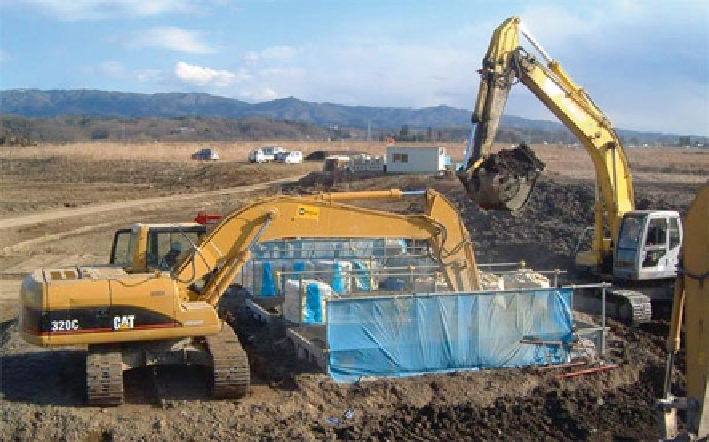Environmental Engineering Reference
In-Depth Information
Fig. 10.8
Construction of river bank in Hamao area, Fukushima Prefecture. The backhoe on the
right
side of the photo is putting in high moisture content mud into the pits; the
left
backhoe with
mixing attachment is mixing with paper and materials and providing agitation
10.2.6.2
East Sendai Channel Construction (Tohoku Regional Development
Bureau of MLIT, Sendai River National Highway Office)
This construction project is from Odawara, district to Honmachi in Aoba district
of Sendai City, to protect Highway 45 with an underground drainage channel of
1.37 km length. The construction started with a basin shaft and facility under the
road at Odawara and progressed through jacking and tunneling with construction
of continuous underground walls formed by self-hardening liquid cement. More-
over, the construction site had adopted a policy of zero emissions, so the fiber-
solidification method was used to treat waste sludges. At the site, the spoil from the
excavation carried out at night in the jacking shaft construction was stored in a pit,
and during the daytime, the soil was solidified using the fiber-solidification method.
Because this was close to the centre of Sendai City, there was little spare room at
the site for the generated sediment, so the solidified sludges were removed as soon
as they were processed by dump truck, and could be used in the nearby Sendai
Route 4 No. 1 bypass widening construction site; as a result, achieving complete
zero emission levels. The site's limited space also required high efficiency heavy
equipment; also vibration and noise levels were measured to ensure low vibration
and low noise construction with respect to the local environment. This makes it an
excellent example of avoiding generation of waste and achieving zero emissions- an
eco-friendly construction site (Fig.
10.9
).

